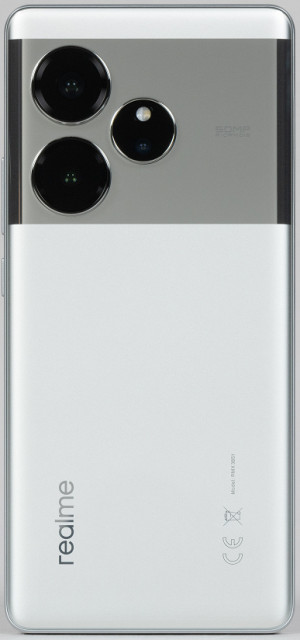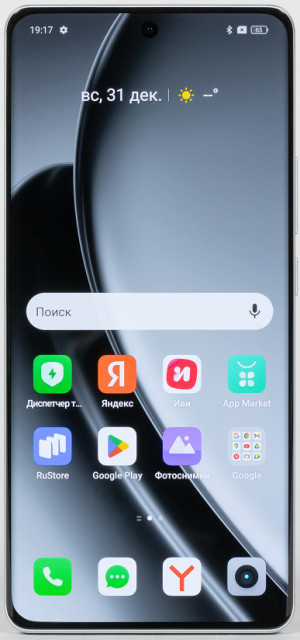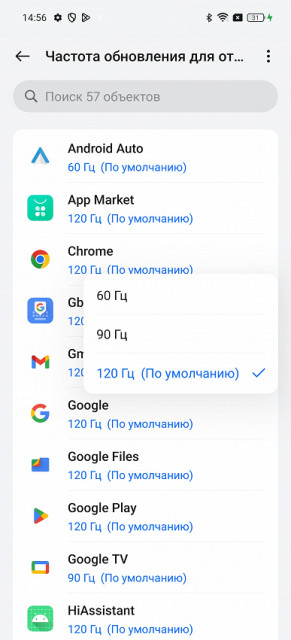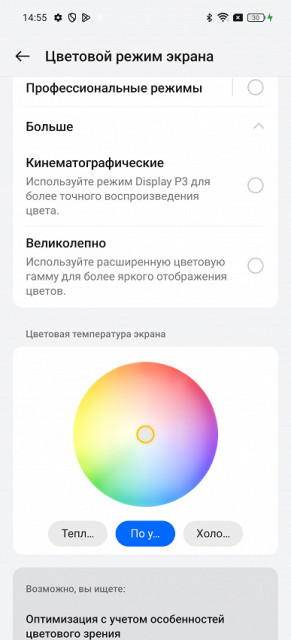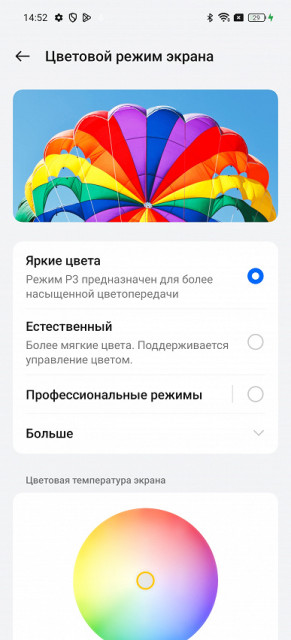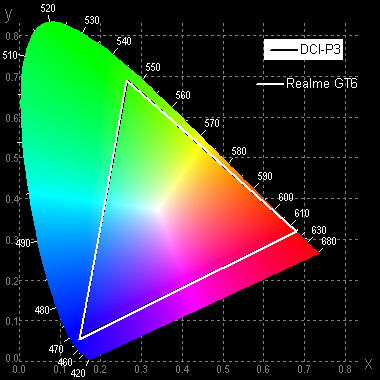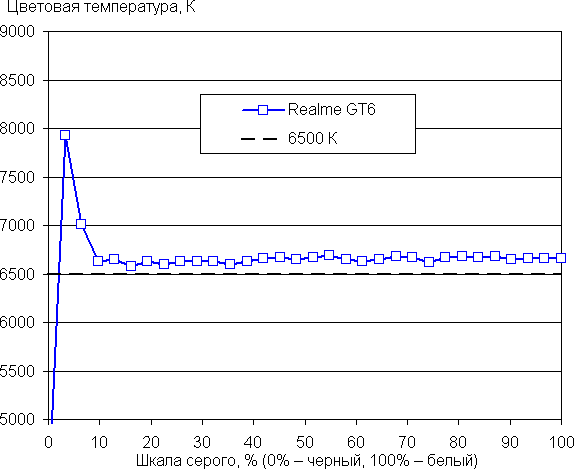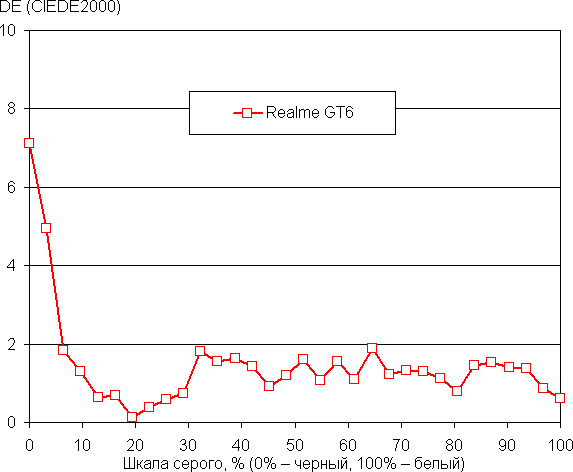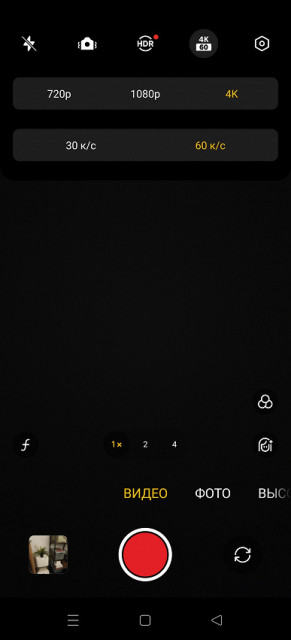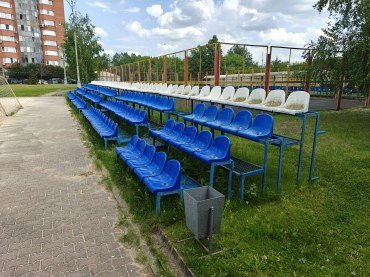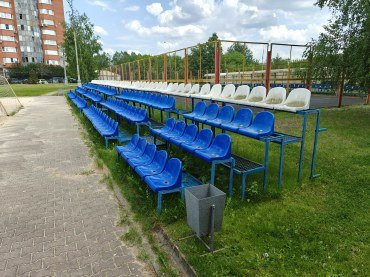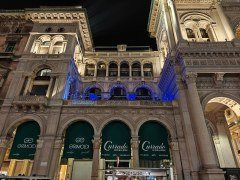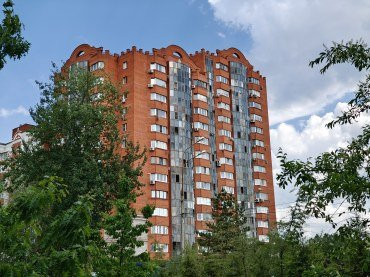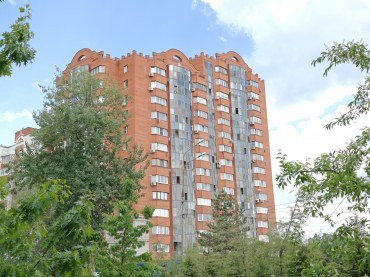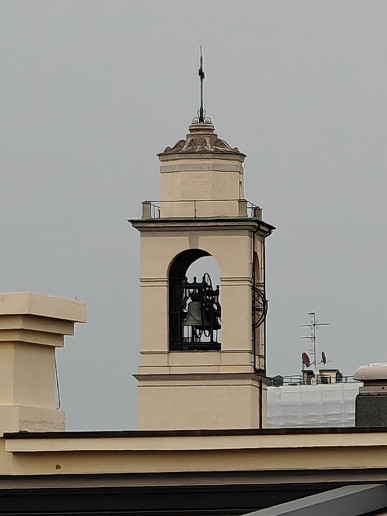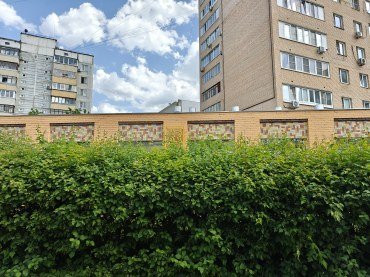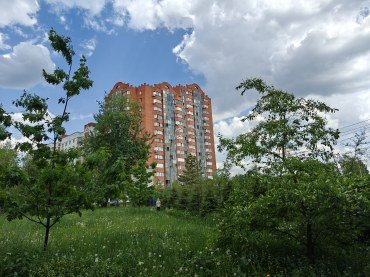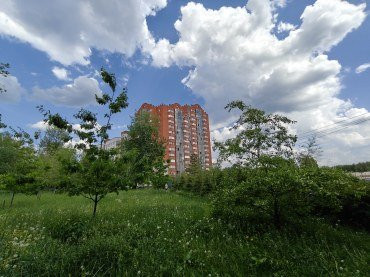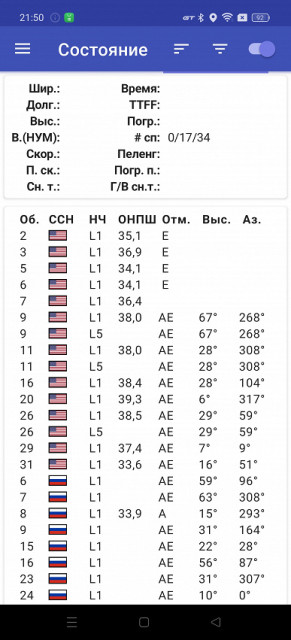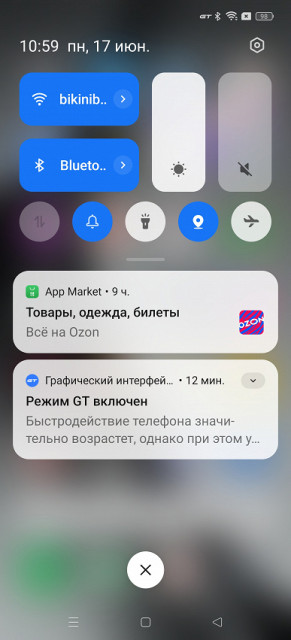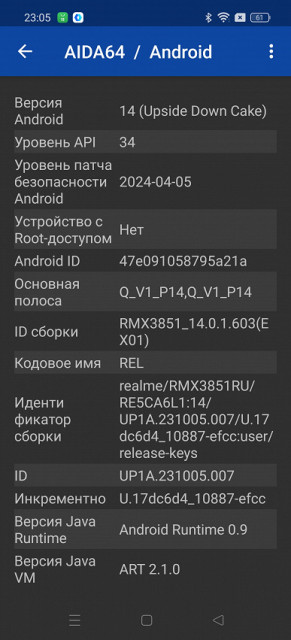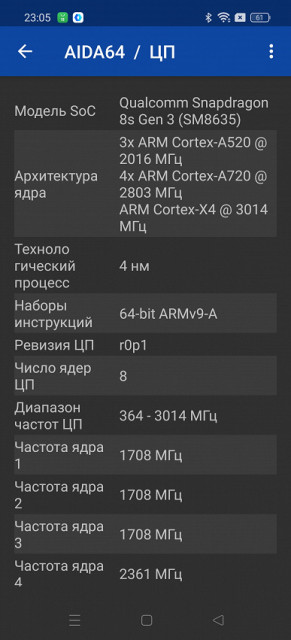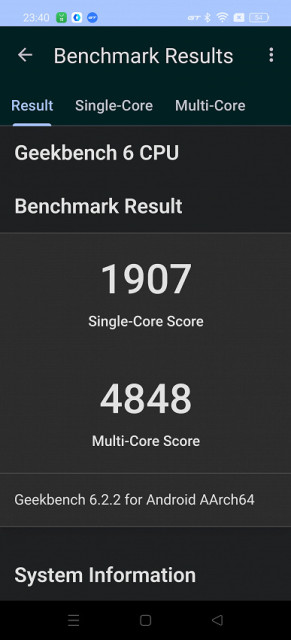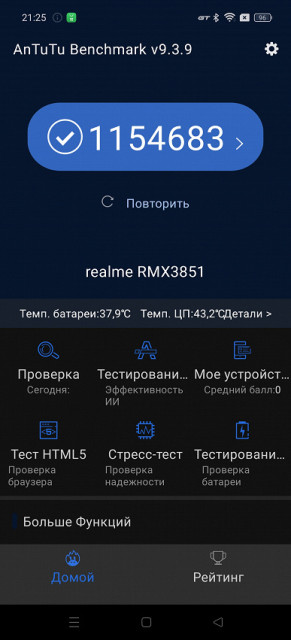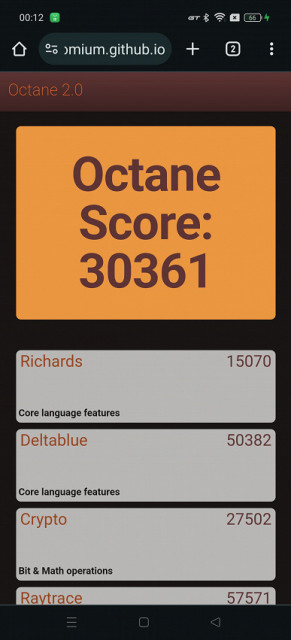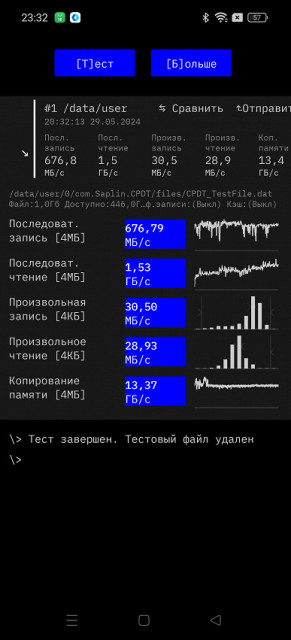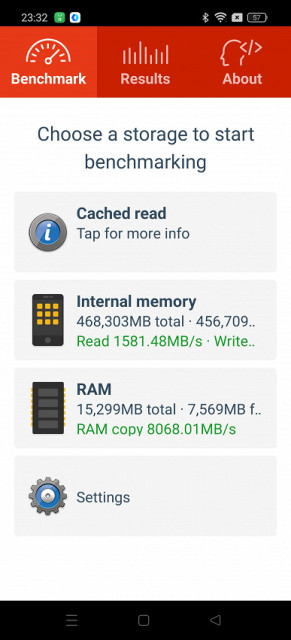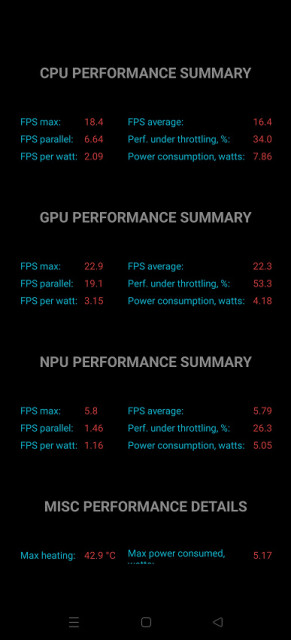Realme GT 6 is the new flagship smartphone of the Realme brand. Since the debut of the first Realme GT 5G in March 2021, the series has become popular among fans of the brand. A year later, Realme GT3 came out. The new Realme GT 6 series integrates advanced AI capabilities and is positioned by the manufacturer as the “new AI flagship killer”.
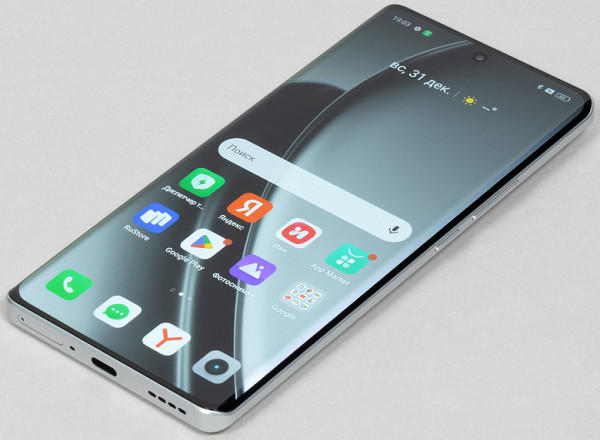
Key Features of Realme GT 6
- SoC Qualcomm SM8635 Snapdragon 8s Gen3, 8 processor cores (1×Cortex-X4 @3.0 GHz + 4×Cortex-A720 @2.8 GHz + 3×Cortex-A520 @2.0 GHz)
- GPU Adreno 735
- Operating system Android 14, Realme UI 5.0
- Touch display AMOLED, 6.78″, 1264×2780, 450 ppi, 120 Hz
- RAM 12/16 GB, internal memory 256/512 GB (UFS 4.0)
- No microSD support
- Nano-SIM support (2 pcs.)
- Networks 2G GSM, 3G WCDMA, 4G LTE, 5G
- GPS (L1+L5), BDS (B1I+B1c+B2a), Galileo (E1+E5a), QZSS (L1+L5), NavIC, Glonass
- WiFi 6
- Bluetooth 5.4, A2DP, LE, aptX HD, LHDC
- NFC
- IR port
- USB 2.0 Type-C, USB OTG
- There is no 3.5mm audio output for headphones
- Rear cameras 50 MP + 50 MP (long-focus) + 8 MP (wide-angle), video 4K@60 fps, gyro-EIS
- Front camera 32 MP
- Proximity and lighting sensors, magnetic field, accelerometer, gyroscope
- Fingerprint scanner (under-screen, optical)
- Protection degree IP65
- Battery 5500 mAh, charging 120 W
- Dimensions 162×75×8.7 mm
- Weight 191 g
Appearance and ease of use
The Realme GT 6 smartphone comes in a standard cardboard box with a stylish, discreet design.
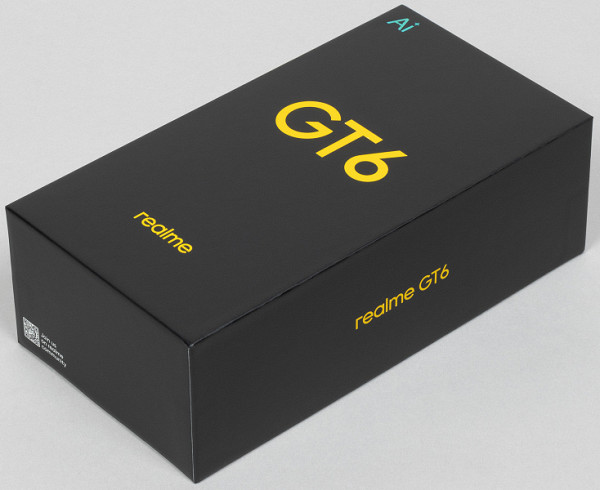
The kit includes an interface cable, a charger with a maximum output power of 120 W and a protective case.

The smartphone has a neat and discreet design. Its streamlined design with curved front and back panels provides a comfortable grip. At the same time, the side frame remains flat and wide enough, which helps to securely hold it in the hand. In this regard, the smartphone is flawless: it fits comfortably in the palm of your hand and is easy to lift from the table.

As for materials, they saved money on the “flagship killer”. The side frame is not made of real metal, but of plastic, painted “metallic”. The manufacturer does not specify what the back panel is made of — real glass or plastic. Most likely, it is also plastic, but stylized as glass.
However, the back panel looks stylish, especially thanks to the mirror insert with camera lenses surrounded by metallic shiny bezels. The insert blends harmoniously with the overall color of the body of both available options, but at the same time stands out in contrast. It’s nice that the camera block does not protrude (although the lenses themselves protrude beyond the body), which makes the design visually light and translucent. In general, despite the plastic side frame, the design of the new product can be called stylish and high quality.
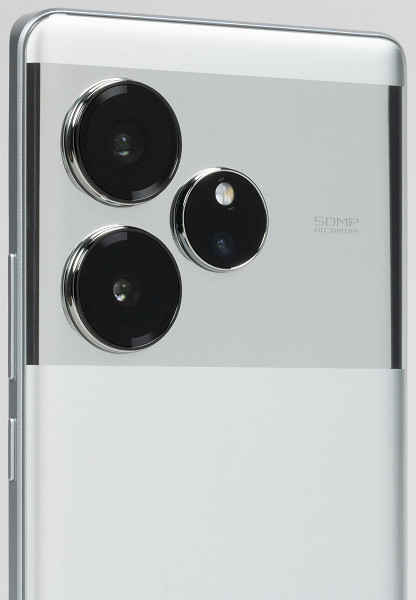
The front glass on this smartphone is premium: Corning Gorilla Glass Victus 2, one of the most durable materials for smartphone displays. According to the releases, “drop protection is increased by 117% and scratch resistance is increased by 100%.” However, the screen again has curved edges, which can be glare and slippery. But Realme sticks to its guns: “The 3D curved display brings out the best in flagship aesthetics, especially when the bezel is less than 2mm on all sides.”

The smartphone has standard dimensions, not too big and not too small. Its weight, less than 200 grams, ensures comfortable holding in the hand and weight for a long time. The device turned out to be well balanced in size and weight.

The buttons on the side panel are large, tall, with a long, elastic stroke and a clear response. The developer did not complicate things and made them perfect. It’s just a pity that the fingerprint scanner was not built into the power button, because this is the most convenient option out there.

The fingerprint scanner is installed at the bottom of the screen under the glass. It works fine, but not faster than a classic capacitive one. The front camera is located at the top of the screen in a circular cutout.
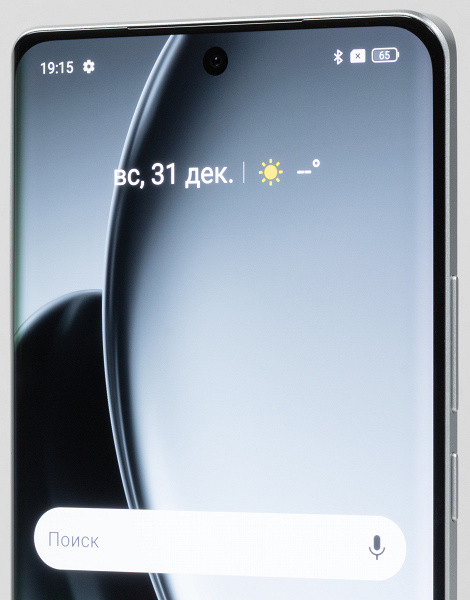
The rear cameras shine stylishly with their bezels, which looks really attractive. However, they stick out quite a lot, which is why the smartphone sways on the table when working with the screen.

This is compensated by the branded thick opaque case included in the kit. It protects the lenses with its rim from contact with the surface, thanks to which the smartphone in the case lies stably on hard surfaces.
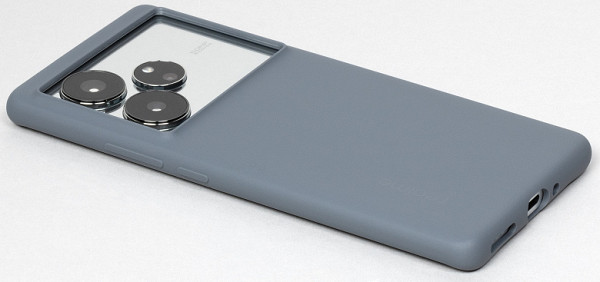
The slide-out tray at the bottom can accommodate two Nano-SIM cards (on one side and the other side of the slide). There is no space for a microSD memory card.
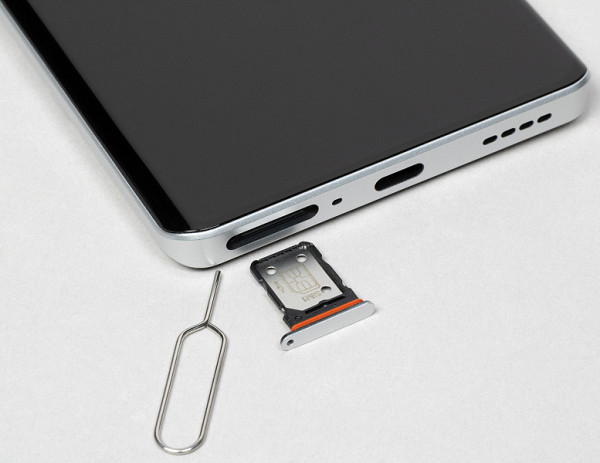
Also at the bottom end there is a speaker, microphone and USB Type-C connector. There is no 3.5 mm audio output for the minijack of wired headphones.

At the top end there is an additional microphone and speaker, and there is also an IR port.

The Realme GT 6 case is protected from dust and moisture according to the IP65 standard. The device arrived on the Russian market in two colors — green and silver

Screen
The Realme GT 6 smartphone features a 6.78-inch AMOLED display with a resolution of 1264 x 2780 pixels (20:9), protected by a curved-edge protective glass. The physical size of the matrix is 72x157 mm, with a dot density of 450 ppi. The width of the frame around the screen from the edge of the matrix to the edge of the body is approximately 1 mm at the top and sides, and 2 mm at the bottom — these are typical figures for smartphones with curved screen edges. The display supports a 120Hz refresh rate.
The screen of the Realme GT 6 is made of a glass plate with a mirror-smooth surface that is scratch-resistant. The anti-glare properties of the screen are slightly better than the screen of the Nexus 7. There is an oleophobic coating on the outer surface, which makes it easier to remove fingerprints and reduces their appearance compared to regular glass.
The maximum screen brightness reaches up to 970 cd/m² with manual control and up to 1580 cd/m² in bright light. These are very high figures. The minimum brightness is 1.6 cd/m², which allows you to comfortably use the device in the dark. There is automatic brightness adjustment based on the light sensor located under the screen to the right of the camera. However, the auto-brightness function may not always work adequately, especially in complete darkness.
At high and medium brightness levels there is noticeable modulation at 360 Hz.
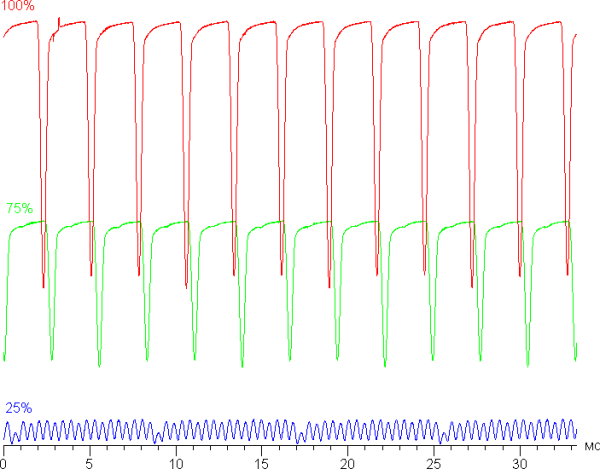
At high and medium brightness, the modulation duty cycle is low and the frequency is high enough that there is no visible flicker. With a significant decrease in brightness, modulation appears at a high frequency (2160 Hz), but there is still no visible flicker.
In the screen settings, a mode with an increased refresh rate of up to 120 Hz is available, while for individual applications you can set your own maximum refresh rate:
At high and medium brightness, the modulation duty cycle is low and the frequency is high enough that there is no visible flicker. With a significant decrease in brightness, modulation appears at a high frequency (2160 Hz), but there is still no visible flicker.
In the screen settings, a mode with an increased refresh rate of up to 120 Hz is available, while for individual applications you can set your own maximum refresh rate:

Let's turn it on and see what happened to the modulation character:

At high and medium brightness levels, the modulation frequency decreased to 120 Hz. How this can reduce the noticeability of flicker is unclear to us.
The screen uses a Super AMOLED matrix — an active matrix based on organic light-emitting diodes. A full-color image is formed using subpixels of three colors: red ®, green (G) and blue (B). However, the number of red and blue subpixels is half that of the RGBG format. This is confirmed by a fragment of a microphotograph.
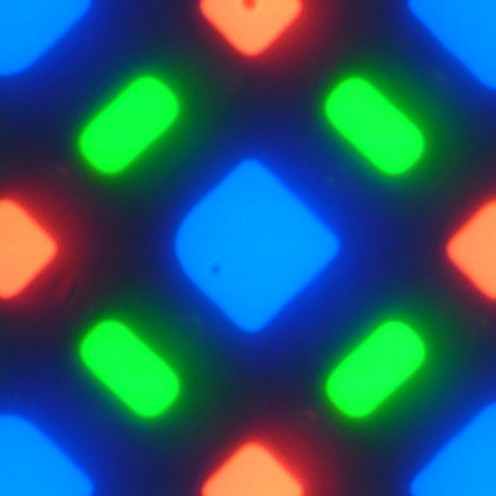
In the fragment above you can see 4 green subpixels, 2 red (4 halves) and 2 blue (1 whole and 4 quarters). This corresponds to the PenTile RGBG format introduced by Samsung for such matrices. The manufacturer estimates screen resolution by the number of green subpixels, which means that the resolution for the other two colors will be lower. Despite some unevenness of contrast borders and other artifacts, due to the high resolution they have minimal impact on image quality.
The screen has excellent viewing angles. Brightness decreases at an angle for both screens, but the drop in brightness on the smartphone is significantly less than on the Nexus 7. Visually, the smartphone screen looks much brighter (compared to LCD screens), especially when viewed from a shallow angle. Whites may take on a faint blue-green tint at wide angles, but blacks remain clear and deep at all angles. This provides a high level of contrast that makes black appear true black.
For comparison, the photographs show the screens of a smartphone and another device with the same images, the set brightness of the screens is about 200 cd/m², and the color balance is set to 6500 K.
A white field is presented perpendicular to the screens.
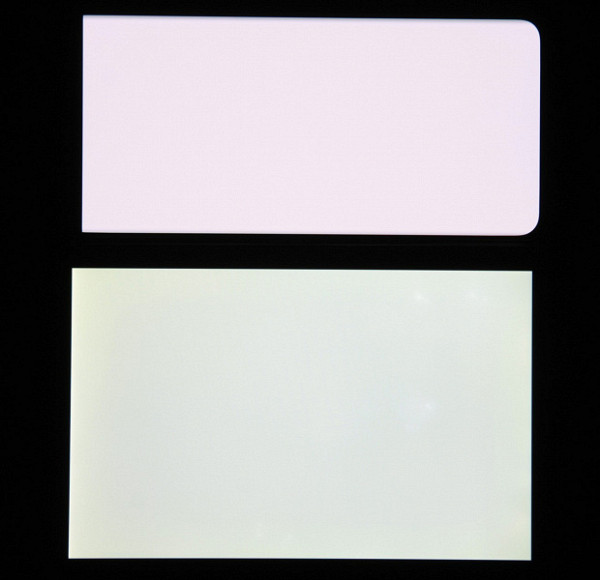
We note good uniformity of brightness and color tone of the white field, with the exception of barely noticeable darkening and a change in hue towards the curved edges.
Test image:

The colors on the smartphone screen are highly saturated (note the tomatoes, bananas, napkin, and facial shade), and the color balance is noticeably different. It is important to note that the photograph is not a reliable source of information about the quality of color reproduction and is provided for illustrative purposes only. The particularly pronounced reddish tint of the white and gray areas found in photographs of the smartphone screen is visually absent when viewed directly, which is confirmed by hardware tests using a spectrophotometer. The reason for this is that the spectral sensitivity of the camera sensor does not exactly match human perception. It is also worth noting that the image in the photograph occupies the entire display area of the screen in a vertical orientation, extending onto the curved edges of the screen, which leads to slight darkening and color distortion. In addition, these areas are often subject to reflections in the light, making images displayed on the entire screen more difficult to view. Even movie images with a 16:9 aspect ratio come up on curved edges, which can interfere with movie viewing.
The photo above was taken with the Vivid Colors profile set by default in the Display Settings. There are four profiles available:
When you select the Cinematic profile, the color saturation is the same, but the color balance changes — the shades become warmer:

In the case of the Superb profile, the color saturation is higher than in the case of the Vivid color profile, and the color contrast is slightly increased:

Whereas in the case of the Natural profile the situation is better:

The saturation on the screen is normal, there is no increase in color contrast, the color balance is close to standard.
Switching the state of the matrix elements occurs almost instantly, however, when turned on, a step with a width of about 17 ms (which corresponds to a screen refresh rate of about 60 Hz) or about 8 ms (at 120 Hz) may appear. For example, this is what the dependence of brightness on time looks like when transitioning from black to white (60 Hz and 120 Hz modes):
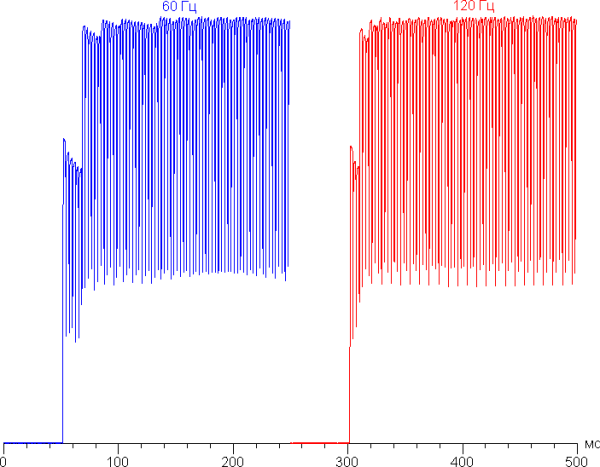
Under some conditions, the presence of such a step can cause plumes that trail behind moving objects.
A gamma curve constructed using 32 points with equal intervals based on the numerical value of the shade of gray showed that there was no significant blockage either in the highlights or in the shadows. The exponent of the approximating power function is 2.20, which corresponds to the standard value of 2.2. The real gamma curve deviates little from the power law:
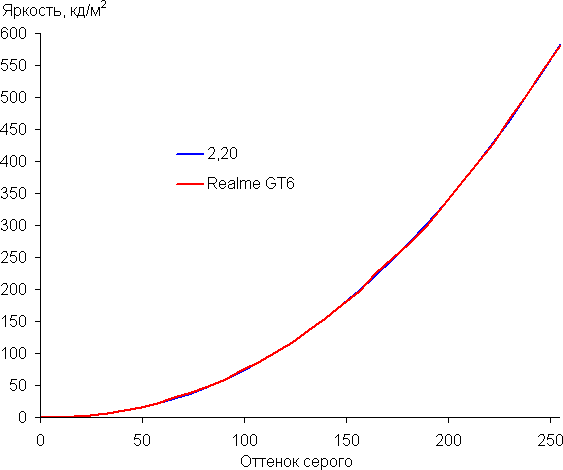
Let us recall that OLED screens are characterized by a dynamic change in the brightness of image fragments depending on the general lighting. As a result, the resulting dependence of brightness on hue (gamma curve) most likely does not perfectly correspond to the gamma curve of a static image, since the measurements were carried out with sequential output of shades of gray over almost the entire screen area.
The color gamut in the Vivid Colors and Cinematic modes exceeds sRGB and approaches DCI-P3:
In the case of the Excellent profile, the coverage is even wider:

When you select the Natural gamut profile, it is compressed to the sRGB boundaries:
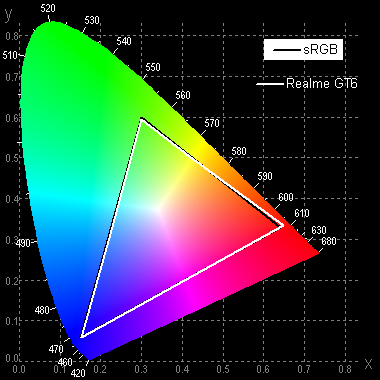
In the case of the Excellent profile, the spectra of the components are very well separated, which allows for wide coverage:

In the case of the Natural profile with maximum coverage correction, the color components are mixed together to a significant extent:

Note that on wide-gamut screens without appropriate color correction, regular images optimized for sRGB devices may appear unnaturally saturated. Therefore, it is recommended that you select the Natural profile in most cases when viewing movies, photos, and other natural images. The Vivid Color or Cinematic profiles are suitable for DCI-P3 content used in digital cinematography, but are rarely used in everyday use.
The balance of shades on the gray scale after selecting the “Natural” profile is very good — the color temperature is close to the standard 6500 K, while over a significant part of the gray scale this parameter changes slightly, which contributes to a better visual perception of the color balance. The deviation from the blackbody spectrum (ΔE) is less than 3 units, which is a good indicator even for professional devices, and the spread of this characteristic is also minimal:
Note that the darkest areas of the gray scale can in most cases be ignored, since color balance is less important there, and measurements of color characteristics at low brightness often have a high error.
Additionally, this device provides the ability to correct color balance by selecting a color temperature profile or adjusting the hue on the color wheel. However, in most cases, selecting the Natural profile is sufficient. Also in the settings you can reduce the intensity of the blue component, which can be useful for improving the comfort of perception of the color gamut.

In bright light, the circadian rhythm may be disrupted, but this can be corrected by reducing the brightness to a comfortable level without distorting the color balance by reducing the blue component.
The Natural Color Mode (PEO) feature is enabled, which automatically adjusts the color balance to environmental conditions. We enabled this feature and tested its effectiveness (using the Vivid Colors profile):
| Conditions | Color temperature on a white field, K | ΔE on a white field |
|---|---|---|
| REO function is disabled | 7700 | 2.1 |
| REO included, LED lights with cool white light (6800K) | 7400 | 2.9 |
| REO is on, halogen incandescent lamp (warm light — 2850 K) | 5400 | 1.6 |
The screen has a high maximum brightness (up to 1580 cd/m²) and excellent anti-glare properties, which makes it convenient for outdoor use even on a bright sunny day. In complete darkness, the brightness can be reduced to comfortable values (1.6 cd/m²). A mode with automatic brightness adjustment, although present, does not work quite adequately.
The screen also has the following advantages: effective oleophobic coating, no visible flicker, high resolution and support for high refresh rate mode (120 Hz). The color gamut is close to sRGB, and the color balance is good when choosing the right profile.
Features of OLED screens such as true blacks and good white field uniformity are also worth mentioning. However, the curved edges of the screen can introduce color distortion and reduced brightness at the edges of the image, especially noticeable in ambient lighting conditions.
Overall, the screen has high image quality and is well suited for both indoor and outdoor use.
Camera
The Realme GT 6 smartphone is equipped with three full-fledged rear cameras: main, long-focus and wide-angle:
- 50 MP, 1/1.4″, 1.12 µm, f/1.69, PDAF, OIS (main)
- 50 MP, 1/2.8″, 0.64 µm, f/2.0, 2× optical zoom (telephoto)
- 8 MP, 1/4.0″, 1.12 µm, f/2.2, 112˚ (wide angle)
The main camera is equipped with a Sony LYT-808 sensor, one of Sony's newest SuperOIS-enabled sensors. The sensor size is 1/1.4 inch and the pixel size is 1.12 microns, making it the largest sensor ever used by Realme in its smartphones. In the new flagship, the developers combined this sensor with an advanced image processing chip, integrating developments in the field of artificial intelligence.
By default, the camera operates in pixel binning mode, taking photos at 12.5 megapixel resolution, but you can also easily switch to shooting mode at full 50 megapixel resolution. Full-size photos undergo no noticeable software processing (noise reduction is likely done in hardware). In terms of detail, we were unable to detect differences between photographs with different resolutions. 50MP photos don't look as pixelated as budget smartphones, but they do have a soft quality and lack of sharpness that makes contrasty fine details the same in both versions. However, retouched images look more attractive overall, with improved contrast and a little more sharpness without being overly forceful. Even in miniatures they look more expressive. Thus, our advice is to always shoot in 12.5MP mode as it offers more balanced image quality.
The camera demonstrates high quality images. They have maximum detail and a wide dynamic range, which allows you to avoid overexposure and loss in shadows. Image sharpness, clarity, contrast and volume are excellent, and thumbnail images have virtually no noise.
Below are additional examples of photos taken with the main camera:
Night mode is very good. The correct balance of exposure has been found, the picture looks truly night-time, but the detail is high, there is no noise, the sharpness and clarity are excellent.
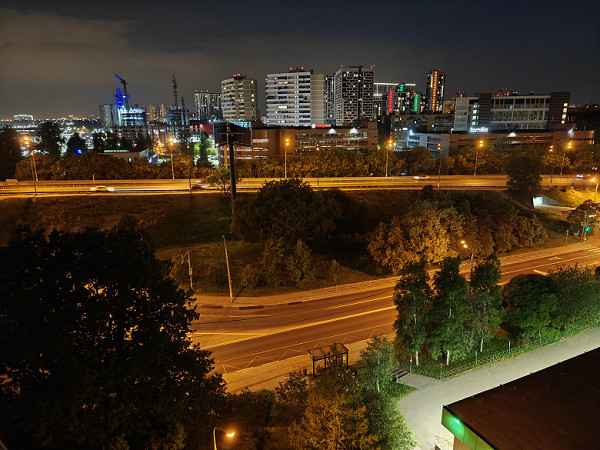
The second camera is equipped with a Samsung JN5 sensor (50 MP) and supports 2× optical zoom. By default, it shoots in pixel binning mode, producing images at a resolution of 12.5 megapixels. In this mode, photographs are distinguished by excellent sharpness and clarity, with high detail. However, when shooting at full 50MP resolution, contrast issues become more noticeable. Despite this, the 2x optical zoom is commendable, although there are some minor color variations at times.
It is possible to use a 4x hybrid zoom, which effectively uses information from the sensor in full-size mode, providing a significant improvement in image quality. How «fair» this zoom is can be debated, but the quality and amount of detail when using this 4x zoom is noticeably higher than the 2x zoom. It is recommended to use this feature!
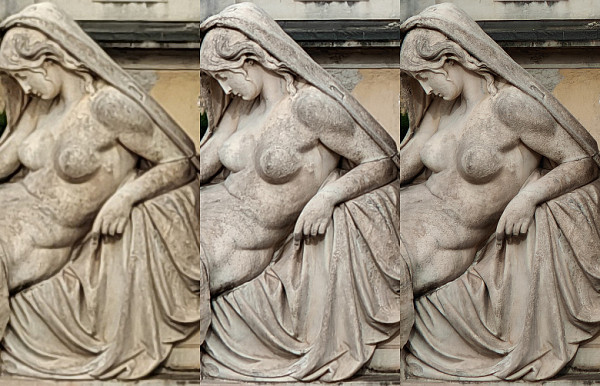
Comparison of photo fragments with zoom 1× (4:1, left), 2× (2:1, middle) and 4× (1:1, right)
The maximum zoom here reaches 20×. This is a purely digital enlargement and is of no interest at full resolution. However, for quickly looking at details that are inaccessible to the normal eye, such a 20x “spotting scope” in your pocket will always come in handy.
The wide-angle module with the Sony IMX355 sensor has problems typical for such smartphone cameras, but its image quality is above average. Sharpness remains at a decent level throughout most of the frame, and colors are oversaturated, which may appeal to many. It is quite suitable as a replacement for the main camera in narrow alleys.
The camera allows you to shoot video in a maximum resolution of 4K at 60 frames per second. Thanks to the powerful processor in the SoC and the flagship image processing chip, the video quality is exceptionally smooth, without the slightest flicker, which puts this smartphone on par with the best devices on the market. The picture is juicy, contrasty, bright, voluminous and detailed, and the sound is recorded perfectly.
The front camera (32 MP, Sony IMX615, f/2.45) deserves the highest marks for image quality. It provides full elaboration of the entire range of lights without blockages in the shadows, high detail and excellent sharpness. Color reproduction is not distorted, and portrait mode almost perfectly distinguishes objects in the foreground from the background.

Telephone and communications
The Realme GT 6 smartphone supports mobile networks up to 5G. In the urban areas of the Moscow region, it demonstrates reliable operation in wireless networks, without losing connections and quickly restoring it after a break. The Wi-Fi adapter supports three bands of Wi-Fi 6, and also supports Bluetooth 5.4 and NFC. However, there is a lack of e-SIM support.
The smartphone is equipped with a dual-channel satellite navigation module that supports GPS (L1+L5), BDS (B1I+B1c+B2a), Galileo (E1+E5a), QZSS (L1+L5), NavIC and Glonass. The first satellites are quickly detected during a cold start, and the positioning accuracy is high.
The voice of the interlocutor in the speaker is clear and loud. The vibration motor has a pleasant feel and uses a 0-Haptics linear vibration motor. Built-in sensors, including a gyroscope, are also present and function properly.
Software and multimedia
The Realme GT 6 software platform uses Android 14 OS with Realme UI 5.0 shell. The interface is solid, well optimized, without intrusive advertising, with full access to Google services.
In the new season, Realme GT 6 developers have focused on integrating and expanding the use of artificial intelligence (AI). AI is being actively implemented in some applications, providing users with new tools to improve the experience of using the device. For example, a photo gallery can use AI to highlight and remove unwanted objects in images. Contextual search in Google is carried out by highlighting an object on the screen. AI is also capable of recognizing text in photographs, translating it into text format (English and Chinese are currently supported) and using it in the future.
Key AI features of the Realme GT 6 series include:
- AI Smart Loop feature allows you to automatically recognize content on the screen and transfer text, images or files to other applications in one motion.
- AI Night Vision mode, which improves the quality of shooting in low light.
- Optimize the screen image, protect your eyesight, extend the life of your smartphone and battery, and optimize performance depending on the task.
Realme GT 6 is equipped with high-quality stereo speakers that produce very loud, clear surround sound. There are no complaints about the audio part. Wireless headphones support Bluetooth 5.4.
Performance
The Realme GT 6 smartphone is powered by Qualcomm SM8635 Snapdragon 8s Gen3 chip. It is equipped with eight processor cores, and graphics tasks are performed by the Adreno 735 GPU. The device is available with 12 or 16 GB of LPDDR5X RAM, and the built-in storage can be 256 or 512 GB (UFS 4.0 standard). Unfortunately, there is no option to install a microSD card. It is possible to connect external devices via the USB Type-C port in USB OTG mode.
This smartphone uses an advanced platform technologically manufactured using the 4nm process. Snapdragon 8s Gen3 is a stripped-down version of the flagship Snapdragon 8 Gen3, featuring an advanced Cortex-X4 core, powerful Adreno GPU for all apps and games, and a state-of-the-art ISP for image processing. A special Hexagon NPU enables neural network operations with 10 billion parameters directly on the device.
To maintain stable performance with high performance, Realme GT 6 is equipped with Iceberg Vapor Cooling System with a vapor chamber of over 100 cm² for efficient cooling. Users can tune processor performance through Geek Power Tuning, adjusting the frequencies of the main CPU cores and graphics core depending on the task — for gaming or to improve energy efficiency.
The smartphone also provides a high level of security using a specialized chip to encrypt sensitive data, ensuring reliable protection of user information.

In practice, Realme GT 6 exhibits high performance, ensuring smooth operation of the interface and the launch of virtual entertainment of any complexity. All games run without lag, even the most demanding ones like Genshin Impact, which runs easily on high graphics settings. The smartphone allows you to run PUBG at up to 120 frames per second, and you can enjoy the game in Genshin Impact in 1.5K resolution.
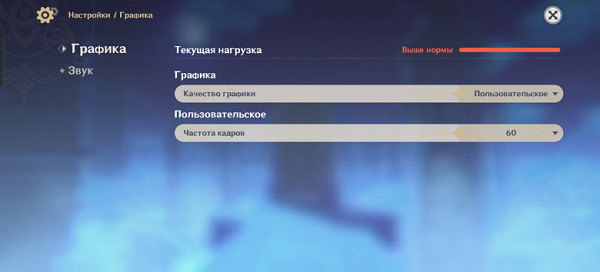
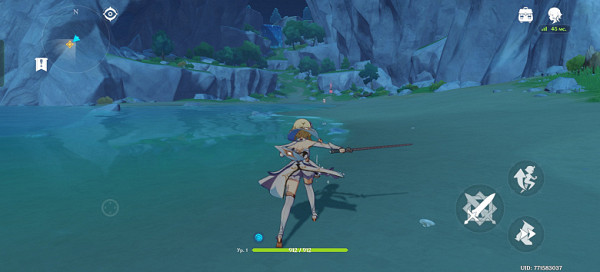
Testing in complex tests AnTuTu and GeekBench:
To make it easier to present the results of testing the Realme GT 6 smartphone and other devices from various segments, we have collected the data in tables. They include several devices tested against the latest versions of popular benchmarks to provide a clear comparison of the resulting numbers. However, due to the limitations of a single comparison, not all models can be presented as some of them were tested on earlier versions of the benchmark programs.
| Realme GT 6 (Qualcomm Snapdragon 8s Gen3) | Samsung Galaxy S24 Ultra (Qualcomm Snapdragon 8 Gen3) | Realme 12 Pro+ (Qualcomm Snapdragon 7s Gen2) | Google Pixel 8 Pro (Google Tensor G3) | Huawei Pura 70 Ultra (Kirin 9010) | |
|---|---|---|---|---|---|
| AnTuTu (v9.x) (bigger is better) | 1154683 | 1806649 | 576685 | 808457 | 969362 |
| GeekBench 6 (bigger is better) | 1907/4848 | 2267/7091 | 894/2801 | 1741/4349 | 1446/4492 |
Testing the graphics subsystem in GFXBenchmark gaming tests:
| Realme GT 6 (Qualcomm Snapdragon 8s Gen3) | Samsung Galaxy S24 Ultra (Qualcomm Snapdragon 8 Gen3) | Realme 12 Pro+ (Qualcomm Snapdragon 7s Gen 2) | Google Pixel 8 Pro (Google Tensor G3) | Huawei Pura 70 Ultra (Kirin 9010) | |
|---|---|---|---|---|---|
| GFXBenchmark Aztec Ruins OpenGL (1080p Offscreen, fps) | 114 | 188 | 35 | 107 | 82 |
| GFXBenchmark Aztec Ruins Vulkan (1080p Offscreen, fps) | 119 | 193 | 39 | 108 | 82 |
| GFXBenchmark Car Chase ES 3.1 (1080p Offscreen, fps) | 90 | 120 | thirty | 78 | 56 |
| GFXBenchmark Manhattan ES 3.1 (1080p Offscreen, fps) | 157 | 204 | 54 | 142 | 60 |
| GFXBenchmark T-Rex (1080p Offscreen, fps) | 384 | 324 | 122 | 328 | 337 |
Testing in browser cross-platform tests:
| Realme GT 6 (Qualcomm Snapdragon 8s Gen3) | Samsung Galaxy S24 Ultra (Qualcomm Snapdragon 8 Gen3) | Realme 12 Pro+ (Qualcomm Snapdragon 7s Gen 2) | Google Pixel 8 Pro (Google Tensor G3) | Huawei Pura 70 Ultra (Kirin 9010) | |
|---|---|---|---|---|---|
| Google Octane 2 (bigger is better) | 30361 | 70812 | 30529 | 52617 | 5180 |
| JetStream (bigger is better) | 91 | 180 | 85 | 102 | 20 |
Memory speed test results:
Heat
We test for performance degradation when heating using the Burnout Benchmark program, which allows you to load the CPU, GPU and NPU:
| Stress on | Heating performance, as a percentage of maximum |
|---|---|
| CPU | 34% |
| GPU | 53% |
| NPU | 26% |
Battery life
The Realme GT 6 smartphone is equipped with a high-capacity battery of 5500 mAh. In tests, this device, being on a modern, economical flagship hardware platform with a 4 nm process technology, demonstrated a very high level of autonomy.
Testing was carried out at normal power consumption levels without activating power-saving features, despite the presence of them in the device. The screen brightness was set to the minimum comfortable level (about 100 cd/m²). The following scenarios were used in the tests:
- Uninterrupted reading in the Moon+ Reader application using the standard light theme.
- Continuous viewing of video in HD quality (720p) via your home Wi-Fi network.
- Playing Injustice 2 with automatic graphics settings.
| Battery capacity | Reading mode | Video mode | 3D gaming mode | |
|---|---|---|---|---|
| Realme GT 6 | 5500 mAh | 32 h 00 m | 27:00 | 9:00 a.m. |
| Samsung Galaxy S24 Ultra | 5000 mAh | 32 h 00 m | 26 h 00 m | 9:00 a.m. |
| Honor Magic6 Pro | 5600 mAh | 38 h 00 m | 30:00 a.m. | 9:00 a.m. |
| Google Pixel 8 Pro | 5050 mAh | 22:00 | 18:00 | 7:00 a.m. |
| Honor 90 | 5000 mAh | 21:00 | 18:00 | 7:00 a.m. |
| Honor Magic V2 | 5000 mAh | 21:00 | 17:00 | 6:00 a.m. |
| Oppo Find N3 | 4805 mAh | 20:00 | 18:00 | 6:00 a.m. |
| Huawei Mate X3 | 4800 mAh | 14:00 | 10:00 a.m. | 5:00 a.m. |
| Oppo Find N2 | 4520 mAh | 20:00 | 17:00 | 5:00 a.m. |
| Oppo Find N2 Flip | 5000 mAh | 20:30 h. | 19:00 | 8:00 a.m. |
All these are the maximum possible figures obtained under “ideal” conditions, including without installed SIM cards. Any changes in the operating scenario will most likely lead to worse results.
The smartphone was charged in 39 minutes from the included 120 W charger. Wireless charging is not supported.
Bottom line
Realme GT 6 offers an excellent AMOLED screen, impressive photo and video capabilities, a wide range of network modules, high performance and long battery life. However, keep in mind that the body materials are not premium, the screen is curved, the processor is classified as sub-flagship, and some network modules such as Wi-Fi 7 and e-SIM support are missing. Wireless charging is also not supported. Overall, this is a typical representative of the sub-flagship segment with very good characteristics for its price range. Whether it will be a “flagship killer” is up to each user to decide. However, the fact remains: for its price, the device offers the highest possible quality and functionality.

